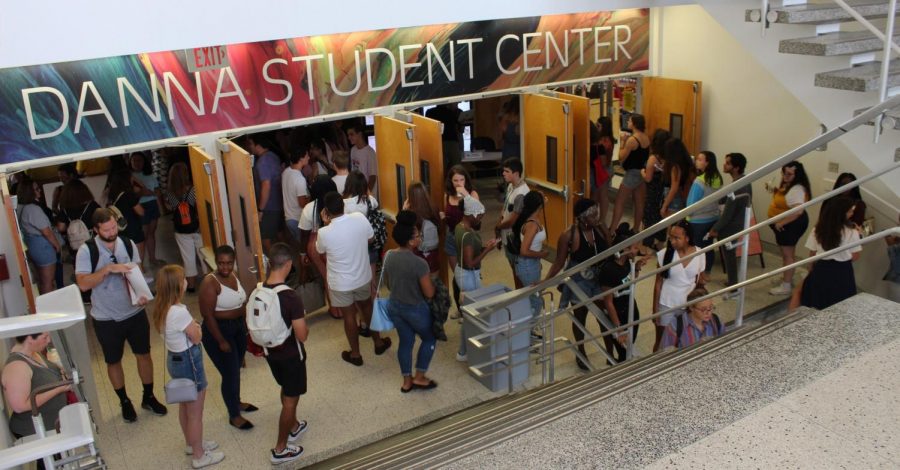Editorial: Wolf PACKED: Too many students, no where to grow
Freshmen scattered around the entrance of the Danna Center. Overcrowding is an issue on people’s minds as our student body grows yearly. Cristian Orellana/The Maroon
August 18, 2019
For the past few years, the Loyola student body has grown substantially, with each new class being larger than the last. While the growth of the community is exciting and makes us optimistic, problems regarding space and size are quickly revealing themselves. From classes getting bigger, to fewer available seats in the Orleans Room, the school is feeling tighter and tighter as the years go on.
It’s no secret to returning students that the residential halls are crowded. Now, 840 freshmen are about to learn that the hard way. A lack of on-campus residential space for the influx of students means closer quarters and more bunk beds. One hundred of this year’s Biever Hall freshmen are living in rooms with two additional roommates, instead of the usual one. While adding one more person to a room may not seem like a big loss in elbow-room, it requires the addition of an extra bed, desk and wardrobe. The space, for many, is just not enough to live comfortably. If incoming classes continue to grow in numbers, these accommodations won’t just be uncomfortable, they will become impossible.
Searching for a last-minute solution, the Office of Residential Life sent an email to all sophomores on June 11 offering the chance for a small number of students to live off campus as decided by lottery. Typically, students have been required to live on campus for their first two years. University President Tania Tetlow said the two-year requirement helps keep students involved with the Loyola community and safer on campus.
The email was sent only two months before sophomores’ move-in day — far too late for most to find affordable off-campus housing. Evidently, the lottery was not completely successful, as there are 12 students still waiting to be placed in on-campus housing: one freshman, and eleven upperclassman, according to Tetlow.
We need a more permanent solution and soon.
While more students on campus certainly creates some logistical challenges, it is clear that the growth of the student body is a positive change for Loyola. More students means more revenue, more diversity and also serves as confirmation that the university is overcoming issues — both financial and structural — we have faced in the recent past. This mass of freshmen is proof that students and parents still have faith in Loyola’s mission.
The school’s response to the rise in numbers however, shows that this sizable freshman class came as a bit of a surprise to administration as well. In a meeting with The Maroon Editorial Board, Tetlow said it wasn’t until mid-June that the incoming class numbers were finalized. She also said this was why the summer lottery email was sent to sophomores later than was convenient.
In our meeting, Tetlow assured us that she is analyzing campus space and availability to decide upon an ideal class size for future years. This process entails examining classroom availability, space in the school’s dining services, residential possibilities and parking. Tetlow also confirmed that the school is actively looking into the possibility of building a new residence hall. While she was unable to confirm specific plans or possible places for the building, she said she already has meetings scheduled to discuss the topic.
This isn’t the first time Loyola has struggled with spacing issues in the Residence Halls. In 2011, Loyola welcomed a freshman class of 950 without nearly enough space to house them all. The school rented a residence hall from the University of New Orleans and bussed freshmen to and from class.
Tetlow said this type of solution would be highly unlikely. But while we definitely don’t wish cross-town bus rides upon freshman, a solution is necessary. Whether that means building a new residence hall or allowing sophomores to live off campus, something needs to happen. You can only squish so many students into Biever. Tetlow also mentioned the possibility of having developers front the cost of construction and then receive the housing costs revenue, something she called a recent trend in higher education.
All challenges considered, too many qualified, diverse and academically eager freshman is a good problem to have. We have spent two years questioning Loyola’s future: probation, layoffs, turnover and budget troubles have at times felt like being on a sinking ship. But seeing the Danna Center full of Loyola’s most diverse and academically successful class in years is a reminder of what makes this university great. We hope that Loyola develops the vision and infrastructure necessary to keep them.






